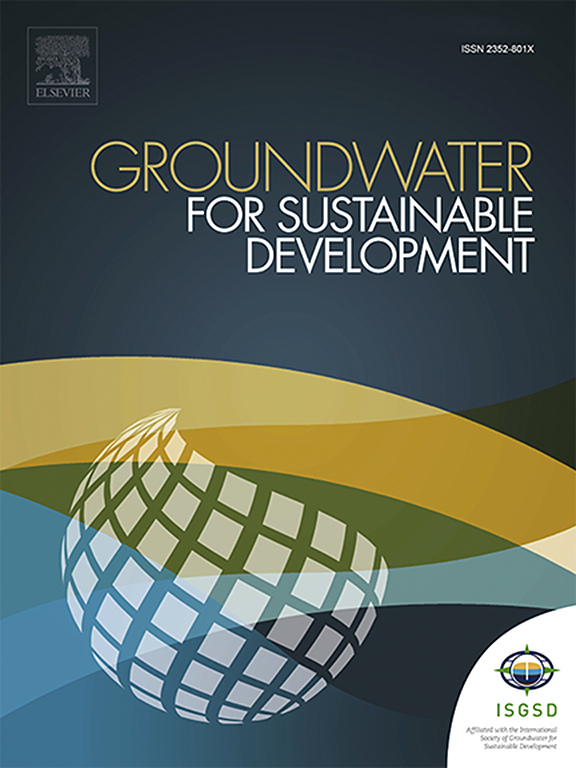气候变化下地下水质量的多尺度聚类时空评价
IF 4.9
Q2 ENGINEERING, ENVIRONMENTAL
引用次数: 0
摘要
地下水水质时空变化评价和脆弱区识别是水资源规划与管理的重要环节。本研究的重点是利用多尺度方法对伊朗阿达比尔盆地地下水水质变量进行评价。这一平原是伊朗重要的工农业地区之一,地下水提供了其总需水量的89%。因此,对该平原的地下水水质进行调查是必不可少的。利用小波变换(WT)和变分模态分解(VMD)分别对2000-2022年26个气压计的月尺度数据集进行去噪和分解。计算子序列的置换熵(PE)值,并将其作为K-means方法的输入,根据总溶解固形物(TDS)和电导率(EC)对盆地进行分区和分类。对中心压电计的EC和TDS进行了预测,并对模型的不确定性进行了研究。从结果来看,地下水资源的过度使用导致即使在多雨年份地下水位也会下降。结果表明,该综合方法具有良好的可靠性。考虑影响地下水污染的水文地质参数,采用DRASTIC方法进行了地下水脆弱性评价。用硝酸盐值对DRASTIC方法进行验证。将硝酸盐离子分布图与易损性图进行匹配,发现两者相对应,表明高硝酸盐点(21 ~ 42 mg/l)多位于易损性潜力较高的区域(中部)。本文章由计算机程序翻译,如有差异,请以英文原文为准。

Spatiotemporal assessment of groundwater quality under climate change using multiscale clustering technique
Assessing spatiotemporal variations of groundwater quality and identifying vulnerable areas is a crucial stage in the planning and management of water resources. This study focuses on utilizing a multiscale method to assess the water quality variables in the groundwater of Ardabil basin located in Iran. This plain is one of the important industrial and agricultural regions in Iran, and groundwater provides 89% of its total water demand. Therefore, investigating groundwater quality for this plain is indispensable. The monthly timescale datasets from 26 piezometers, covering the period of 2000–2022, were de-noised and decomposed using the Wavelet transform (WT) and Variational Mode Decomposition (VMD), respectively. The Permutation Entropy (PE) values of the subseries were computed and considered as inputs of the K-means method to zone and classify the basin in terms of the Total Dissolved Solids (TDS) and Electrical Conductivity (EC). The EC and TDS of central piezometers were predicted and the modeling uncertainty was investigated. From results, excessive use of groundwater resources resulted in a drop in groundwater levels even in rainy years. It was found that the integrated approach exhibited a desirable degree of reliability. Groundwater vulnerability assessment was done considering the hydrogeological parameters affecting groundwater pollution and using the DRASTIC approach. Nitrate values were used to validate the DRASTIC method. Matching the nitrate ion distribution map to the vulnerability map showed that the two maps corresponded, indicating that most of the points with high nitrate (21–42 mg/l) were located in areas with higher vulnerability potential (central parts).
求助全文
通过发布文献求助,成功后即可免费获取论文全文。
去求助
来源期刊

Groundwater for Sustainable Development
Social Sciences-Geography, Planning and Development
CiteScore
11.50
自引率
10.20%
发文量
152
期刊介绍:
Groundwater for Sustainable Development is directed to different stakeholders and professionals, including government and non-governmental organizations, international funding agencies, universities, public water institutions, public health and other public/private sector professionals, and other relevant institutions. It is aimed at professionals, academics and students in the fields of disciplines such as: groundwater and its connection to surface hydrology and environment, soil sciences, engineering, ecology, microbiology, atmospheric sciences, analytical chemistry, hydro-engineering, water technology, environmental ethics, economics, public health, policy, as well as social sciences, legal disciplines, or any other area connected with water issues. The objectives of this journal are to facilitate: • The improvement of effective and sustainable management of water resources across the globe. • The improvement of human access to groundwater resources in adequate quantity and good quality. • The meeting of the increasing demand for drinking and irrigation water needed for food security to contribute to a social and economically sound human development. • The creation of a global inter- and multidisciplinary platform and forum to improve our understanding of groundwater resources and to advocate their effective and sustainable management and protection against contamination. • Interdisciplinary information exchange and to stimulate scientific research in the fields of groundwater related sciences and social and health sciences required to achieve the United Nations Millennium Development Goals for sustainable development.
 求助内容:
求助内容: 应助结果提醒方式:
应助结果提醒方式:


